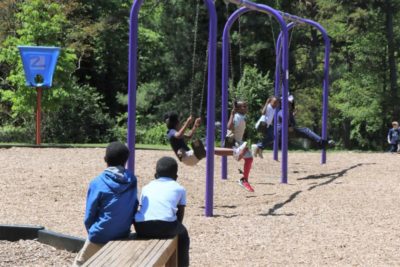The NC House Education Committee recently moved forward a bill to pilot and potentially scale an online early learning program for low-income preschool-aged children who are not currently accessing NC Pre-K. The online program is intended to be used for 15 minutes a day, five days a week, and is proposed as an alternative early learning option for children who are eligible for NC Pre-K but not receiving the service because of waitlists or barriers like transportation.
Research demonstrates that an online program is not an effective substitute to high-quality preschool. Is the proposed program worth investing in in the short-term as the state ramps up to universal preschool? The research is mixed.
Research supports high-quality preschool environments
Research is clear that high-quality preschool administered in classrooms is preferable to online programs. A recent National Institute for Early Education Research (NIEER) report identified key features common to highly effective state preschool programs and set benchmarks for policies related to those features, including:
- Early Learning and Development Standards that are comprehensive, aligned with standards for older and younger children, supported, and culturally sensitive.
- A curriculum that includes specificity regarding key domains of language, literacy, mathematics, and social-emotional development, has an approval process and training and technical assistance for implementation.
- Lead teachers with at least bachelor’s degrees.
- Lead teachers with specialized preparation that includes knowledge of early learning and child development.
- Assistant teachers with Child Development Associate (CDA) degrees or equivalent training.
- Staff professional development of at least 15 hours of annual in-service training, including through coaching or similar ongoing classroom-embedded support.
- Maximum class size of 20 and max staff-child ratio of 1:10.
- Screenings and referrals for vision, hearing, and other health needs for all enrolled children.
- Continuous Quality Improvement System (CQIS) that includes data collected annually and used to improve policy or practice.
NCECF reported recently that NC Pre-K receives high marks from NIEER for program quality, meeting all but two of the benchmarks. An online early learning program does not meet the benchmarks that make a program like NC Pre-K effective. Research demonstrates that young children learn best through play and relationships with caring adults.[i]
NC Pre-K and other high-quality preschool options also provide the opportunity for parents to work while their children are safe and learning, which an online option cannot provide.
NC Pre-K not fully funded to meet the need
NC’s leaders seem to agree that online learning is not an effective substitute for high-quality preschool, as state funding for NC Pre-K has increased in recent years. The Governor and House 2019-21 budget proposals both recommend raising the NC Pre-K reimbursement rate, which would allow more child care providers to participate in the program. Increasing the reimbursement rate was one of several recommendations to increase enrollment in NC Pre-K made by a recent NC-specific NIEER report. Watch our recorded webinar for more on that report. Despite recent increases in funding for the program, in 2018, less than half (47%) of eligible NC four-year-olds were able to participate in NC Pre-K.[ii]
Online early learning program aims to impact early reading and math skills
As the state ramps up investment in NC Pre-K to ensure that every eligible 4-year-old has access to a high-quality preschool program, the General Assembly is considering whether this online early learning program is a worthy investment, on the theory that something is better than nothing. The research behind that thinking is mixed.
The proposed three-year pilot will provide families in selected districts with access to a virtual early learning program called UPSTART. The home-based program is primarily delivered to children by computer and the Internet. Computers and Internet connectivity will reportedly be provided at no cost to qualifying NC families. Developed by a Utah-based company, UPSTART software uses adaptive lessons, digital books, songs, and activities. Children are encouraged to use the program for 15 minutes a day, five days a week with resources and technical assistance offered to parents. UPSTART focuses on the development of academic skills that allow children to be successful in kindergarten, such as early reading and math skills.
UPSTART is currently being used in 15 states and is reported to have good results by external evaluators. Graduating students in Utah showed improvements in early literacy skills. It should be noted, however, that the majority of the graduating students in Utah were white, living above the poverty line, and English-speaking, which does not match the population eligible for NC Pre-K in North Carolina. Utah’s UPSTART program evaluation report can be viewed here.
NCECF’s NC Pathways to Grade-Level Reading Working Paper on Reading with Children highlights research on the use of technology as a reading aid with children.
In 2016, the U.S. Department of Education and Health and Human Services published the following guidelines for the use of technology with children:[iii]
- Technology—when used appropriately—can be a tool for learning.
- Technology should be used to increase access to learning opportunities for all children.
- Technology may be used to strengthen relationships among parents, families, early educators, and young children.
- Technology is more effective for learning when adults and peers interact or co-view with young children.
The American Academy of Pediatrics (AAP) recommends limiting screen use to one hour per day of high-quality programming for children ages 2 to 5 years old.[iv] They report that today’s children spend an average of seven hours a day engaging with television, computers, phones and other electronic devices. Data shows that low-income children and children of color spend more time in front of screens than their more affluent, white peers.[v] This gap in play time puts these children at additional risk for negative emotional, physical, and academic outcomes.
The AAP also emphasizes the importance of parents viewing and engaging in the media with their children to help them understand and apply what they are viewing. Recent research shows that children as young as 15 months can learn new vocabulary from technology if parents are sitting next to them reading the words and talking interactively with them. [vi] When parents believe apps and online programs have educational value for their children, they are twice as likely to make them available. [vii] UPSTART offers resources to support parent involvement such as help with technology and activities to do with their children offline. It is unclear what the average level of parental involvement includes or how it is monitored and evaluated.
Time for creative, exploratory, and unrestricted play in home and school environments is critical for social emotional health and cognitive development among preschoolers. A recent meta-analysis suggests that in many preschool settings serving low-income children, American early education is paying less attention to young children’s social emotion development by moving away from rich learning environments involving art and play and towards more academic instruction.[viii] While some components may be included, UPSTART does not focus on the development of social emotional skills that support a successful start in kindergarten and may take away from time for play at home.
Progress of online early learning legislation at the General Assembly
The Governor’s budget proposal did not include the online early learning pilot. The legislation was included in the House budget, along with $1 million in funding for the pilot. The funding was removed and put back in during the amendment process, and the final House budget includes the legislation and nearly all the $1 million in funding (minus $1000 that went to another education priority). The Senate should release their budget proposal this week.
The vision of NCECF’s Pathways to Grade-Level Reading Initiative is that all North Carolina children, regardless of race, ethnicity or socioeconomic status, are reading on grade-level by the end of third grade, and all children with disabilities achieve expressive and receptive communication skills commensurate with their developmental ages, so that they have the greatest opportunity for life success. To learn more about actions that support NCECF’s vision and an accessible and high-quality education for all NC children, read the Pathways Action Framework.
Sources:
[i] What Works for Third-Grade Reading: Social Emotional Health. NC Pathways to Grade-Level Reading Working Paper. Retrieved May 9, 2019 from https://files.buildthefoundation.org/wp-content/uploads/2018/07/Pathways-Social-Emotional-Health_Draft.pdf
[ii] Barnett, S., Barriers to Expansion of NC Pre-K: Problems and Potential Solutions. NIEER. Retrieved May 14, 2019 from http://nieer.org/research-report/barriers-to-expansion-of-nc-pre-k-problems-and-potential-solutions
[iii] What Works for Third-Grade Reading: Reading with Children. NC Pathways to Grade-Level Reading Working Paper. Retrieved May 9, 2019 from https://files.buildthefoundation.org/wp-content/uploads/2018/07/Pathways-Reading-with-Children_Draft.pdf
[iv] American Academy of Pediatrics Announces New Recommendations for Children’s Media Use (2016). American Academy of Pediatrics. Retrieved May 9, 2019 from https://www.aap.org/en-us/about-the-aap/aap-press-room/Pages/American-Academy-of-Pediatrics-Announces-New-Recommendations-for-Childrens-Media-Use.aspx
[v] Rideout, V. (2017). The Common Sense census: Media use by kids age zero to eight. San Francisco, CA: Common Sense Media. Retrieved May 9, 2019 from https://www.commonsensemedia.org/sites/default/files/uploads/research/csm_zerotoeight_fullreport_release_2.pdf
[vi] What Works for Third-Grade Reading: Reading with Children. NC Pathways to Grade-Level Reading Working Paper. Retrieved May 9, 2019 from https://files.buildthefoundation.org/wp-content/uploads/2018/07/Pathways-Reading-with-Children_Draft.pdf
[vii] and [viii] What Works for Third-Grade Reading: Social Emotional Health. NC Pathways to Grade-Level Reading Working Paper. Retrieved May 9, 2019 from https://files.buildthefoundation.org/wp-content/uploads/2018/07/Pathways-Social-Emotional-Health_Draft.pdf
Editor’s note: This perspective was first posted by the North Carolina Early Childhood Foundation. It has been published with the author’s permission.





